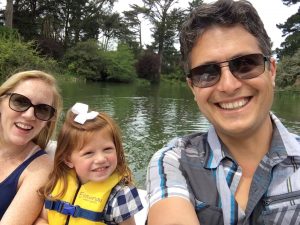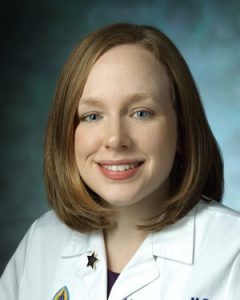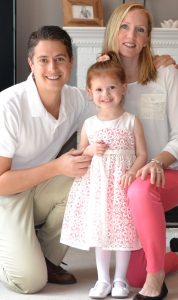It was a typical evening and 3-year-old Laney Jaymes Fitzsimons was in the bathtub when she began slurring her words. The “super subtle” slur was gone within seconds and Laney’s parents, Brian and Laura, assumed their little girl was simply tired. The family had just returned from a vacation in the Arizona desert, where Laney, a happy child with auburn hair and a gap between her tiny front teeth, had hiked for miles.
But weeks later, when the slur returned, this time accompanied by a facial droop, the Fitzsimons knew something was very wrong. Laney was rushed to their local emergency room where she was transferred to a larger hospital and stayed for an overnight EEG, or electroencephalogram. An MRI would have helped pinpoint the cause, but because it was the weekend, the procedure was not given due to an anesthesiologist not being available, and Laney was spared the trauma and risk of sedation.

Days later, Laney endured another episode, now more severe and with trouble walking. Her parents rushed her to the hospital again, where she was diagnosed with epilepsy and placed on a powerful antiseizure medication. One week later, at a neurologist visit, Laney was diagnosed with complex partial seizures, and directed to continue the anti-seizure medication. An MRI was now postponed to avoid the risks of anesthesia and trauma on Laney.
Laney then developed a severe drug reaction to that medication, and was given a new one. The following morning, one month after Laney slurred her words in the bathtub, Laura found her in bed, too weak to sit up and unable to speak. Finally, the child underwent an MRI, and doctors informed the Fitzsimons their daughter had not been having seizures, but rather had suffered multiple acute strokes. “She had been stroking for three weeks straight,” says Laura. It was the first time either Brian or Laura had heard the word “stroke” since their daughter’s symptoms began.
“In any adult, these symptoms would have been immediately recognized as a warning sign of impending stroke. But because Laney was 3 years old, she was misdiagnosed with complex partial seizures,” explains Lisa Sun, Med ’11 (MD), a Johns Hopkins neurologist and an associate professor of neurology, who later became Laney’s doctor. Tragically, the misdiagnosis meant Laney went weeks without the kind of care that could have saved her life and given medicine that made strokes more likely.

Over the next six months, Laney would spend months in the hospital, undergo brain surgery, and brave countless hours of rehabilitative therapy, slowly regaining an ability to communicate in her own way, sit up on her own, and even hold her little sister Brielle. But near the end of 2016, she experienced another major stroke. Laney passed away on March 27, 2017.
Despite their overwhelming grief, Brian says he and Laura immediately “felt an urgency to make sure people knew about pediatric stroke so that what happened to Laney didn’t happen to anyone else.”
“It wasn’t right,” Laura says, “all the misdiagnoses. It wasn’t okay. It couldn’t just end there.”
And it didn’t. Soon after Laney’s death Brian and Laura started the Laney Jaymes Foundation, a nonprofit dedicated to expanding pediatric stroke awareness, supporting research into the condition, and providing adaptive equipment to children who have suffered from stroke.
According to Sun, every year about five out of every 100,000 children experience a stroke. There are a variety of causes, the most common of which are heart disease and diseases of the blood vessels of the head and neck. Laney’s strokes were the result of undiagnosed moyamoya, a cerebrovascular disease in which the blood vessels at the base of the brain narrow and close off.

Because pediatric strokes are so rare, most health care providers aren’t trained to recognize them. “Pediatricians might see one stroke in their careers,” says Sun. “We need to educate pediatricians, nurses, and EMTs to know the signs.”
Within a year of Laney’s passing, members of the foundation attended a hearing to support a Maryland bill that would require pediatric stroke training to childcare providers and educators. Brian provided testimony about the family’s ordeal.
Another barrier to prompt diagnosis is the need for the patient to undergo an MRI, a test that can be risky for children because anesthesia is involved. Sun and her team are working on developing an ultrasound technology that doesn’t require sedation — or an anesthesiologist, who are in short supply on weekends — that donations from the foundation have supported.
But even when stroke is diagnosed, treatment for kids still lags far behind their adult counterparts. “Stroke is super common in adults and so doing studies in adults is easier,” explains Sun. “We just don’t have the same data for kids.”
In 2019, the foundation funded The Laney Jaymes Foundation Research Project in the Johns Hopkins Department of Neurology, a research initiative to better understand what causes pediatric stroke and the best ways to treat it. “The money has laid the groundwork for studies and collaboration with people from around the world,” Sun says.
In addition to advocacy and research, the Fitzsimons are committed to helping kids who have had strokes live life as fully as possible. The foundation has provided funding for families to purchase physical therapy gear, wheelchair ramps, adaptive bicycles, and other life-changing equipment.
According to Brian, the foundation is receiving an increasing number of requests for equipment grants. “We’re a bigger name now with rehabilitation centers,” he says, “which is great, but means we need to raise more money.” The foundation has hosted fundraising fun runs and golf tournaments; a music festival could be next.
Sun, too, isn’t slowing down in her mission to raise awareness around pediatric stroke. The neurologist keeps a photo of Laney and her sister Brielle on her desk and says meeting the family has fundamentally altered her trajectory. “Laney set my career path. I saw so many ways her care could have been improved. But despite all her difficulty, she had a spark about her. She was very loved. Doctors, therapists, everybody loved this little girl.”
For Laney’s parents, the foundation in her name has been a way to cope with grief. “I talk about Laney all of the time, and it is very important to me that people feel comfortable talking about her,” Laura says. “I want her spirit and her name to live on.”
Interested in supporting efforts to recognize the signs of stroke in children?
Topics: Faculty and Staff, Foundations, Friends of Johns Hopkins Medicine, Johns Hopkins Medicine, Neurology, Promote and Protect Health